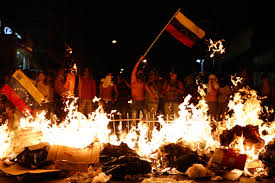As I was searching for ideas for my final paper, I was originally drawn to disability memoir Cockeyed and perhaps considering the life narrative as an attempt to negotiate entrenched power dynamics between disability groups and the dominant groups. As argued by Couser, disability life narratives enable traditionally marginalized groups to re-gain some control over their own representation and thus to contribute to the construction of their collective identity (31).Therefore, I considered perhaps exploring the means through which Cockeyed acts as a counter-narrative to the hegemonic representations of the blind.
However, given the inconceivable violence of protests in Venezuela over the past two weeks, in addition to the frequency with which stories, videos and articles have appeared in my Facebook news feed, I couldn’t help but begin to wonder some of the possible lens or angles that I could use to explore the crisis in my term paper. Having recently read Jiwani and Young’s article Missing and Murdered Women: Reproducing Marginality in News Discourse on media representation of vulnerable subjects, I thought that one way I could approach the paper could be by researching the Western media’s representation of Venezuela and its citizens in the recent protests (through digital media outlets e.g. CNN, BBC). I could possibly identify the dominant frames and counter-frames in the articles, and then proceed to critically assess some of the potential geo-political meanings and implications underlying the discourse. What are the major frames or tropes used to represent the country? As I browsed through the articles from CNN I kept noticing that inflation, corruption, state violence, shortages continuously emerged in the introductory remarks, constructing an image of a crippled and desperate nation struggling to cope with an unstable government and an ever-increasing burden of an financial and socio-economic troubles. Yet in the series of articles since February 12th, are the voices of Venezuelan citizens heard, or are they silenced and eclipsed by the voices of Western political analysts and journalists?
Nevertheless, after discussing my research topic with Professor McNeill, I realized that since the resistance movement by the opposition group seems to be in full swing and shows no sign of faltering, it is likely that the media will continue to cover stories in the region. Therefore, the data may not provide a holistic view on the Western media representation of the Venezuelan crisis.
With this in mind, I have decided to alter my research topic to explore the functions of digital storytelling in Youtube videos of human rights protests. Specifically, I am interested exploring how storytelling of protests through social media can contribute to dismantling and destabilizing the embedded power dynamics that transfer authority to media institutions, by offering an alternative “insight” and thus feeding in to the construction of the collective national identity. What are recurring patterns that emerge in Youtube videos by individuals explaining human rights and resistance movements?
As part of their study of life narratives in the field of human rights, Schaffer and Smith contend that autobiographical accounts relating to human rights are often products of particular kairotic moments of transformation (1) and often arise due to local movements. Such movements generate “occasions for witnessing to human rights abuse” (4) and for collective remembrance of the past, offering space for the voices of those at the margins to be heard. This is further substantiated by Poletti in her article, Coaxing an intimate public: Life narratives, where she argues that since digital stories focus on bringing in the voices of marginalized individuals, they offer an “experience of inclusion and community building” as well as “empowerment”, diversifying the voices in the public sphere. I considered perhaps looking at the following video: “What’s happening in Venezuela in a nutshell? (English version)”. However, since I want to be able to capture a series of recurring patterns in order to synthesize an argument on the key strategies harnessed by these digital narratives and their potential functions, I will also browse Youtube in search of other videos on renowned protests in Syria, and in Kiev, Ukraine.

